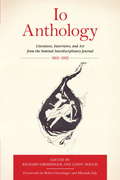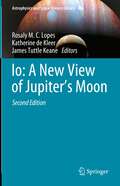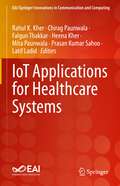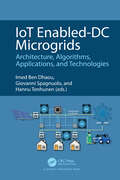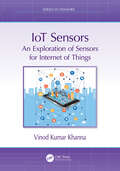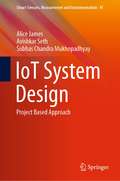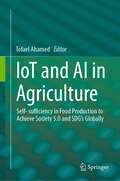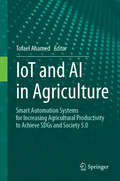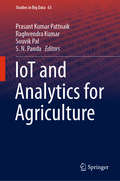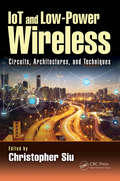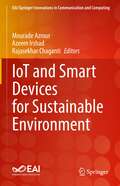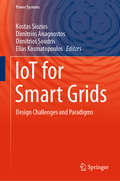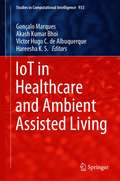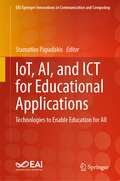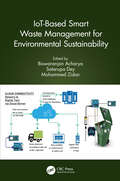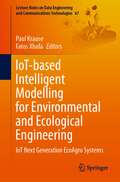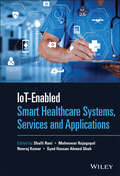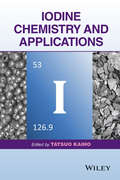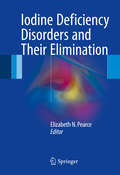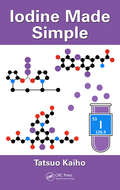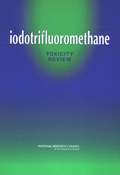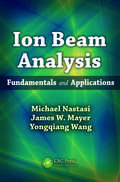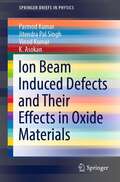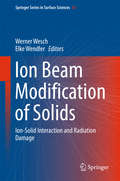- Table View
- List View
Io Anthology
by Miranda July Richard Grossinger Lindy Hough Robin GrossingerIo Anthology celebrates the fiftieth anniversary of this formative journal and commemorates its role in opening a path to decades of innovative publishing.Bringing together in one volume the quirky blend of artistic and scholarly writing that characterized the literary journal, this book is a "greatest hits" collection of the major pieces published from 1965 to 1993. It features very early work from Stephen King, Gary Snyder, Jayne Anne Phillips, and many others, with forewords by writer and filmmaker Miranda July and historical ecologist Robin Grossinger, the daughter and son of the editors, who grew up with Io and were in part initiated in their careers by its household presence. Io forged an eclectic path through the upheaveals of the 1960s in art, literature, science, and the life of the spirit with writing that embraced astrophysics, science fiction, parapsychology, topology, poetry from Black Mountain, Beat, and New American traditions, wisdom from Hopi and Iglulik elders, homeopathy, hermetics, alchemy and the occult, astrology, Tibetan Buddhism, and Sufism. Portraying the roots and spirit which impelled Io to evolve into a publishing company, this volume shows the seriousness and depth of content which continues to enliven North Atlantic Books.From the Trade Paperback edition.ng the continuity of purpose and content between North Atlantic Books, which grew out of the magazine, this volume chronicles the voices and spirit that continue to enliven the publishing vision that persists to this day.
Io: A New View of Jupiter’s Moon (Astrophysics and Space Science Library #468)
by Rosaly M. C. Lopes Katherine De Kleer James Tuttle KeaneWritten by expert researchers, this book covers all the major aspects of research in Jupiter's moon Io, from the interior to its space environment. Io is one of the Solar System’s most exotic satellites. The book discusses Io's interior, geology, atmosphere, and, in particular, its active volcanism, which was discovered from observations by the Voyager 1 spacecraft in 1979, confirming a possibility suggested from theoretical studies based on Io’s orbit. Our knowledge of Io’s volcanism, composition, and space environment was significantly increased as a result of observations by other spacecrafts, including Galileo.More than a decade after the 1st edition, “Io After Galileo”, this 2nd edition of the book now includes results obtained by the New Horizons mission and, more recently, Juno. It also presents observational results from ground-based telescopes using adaptive optics having provided resolutions that rival those of spacecraft.The book provides a review of the current status of Io research and gives an outlook to planned future observations. It thus serves as reference for researchers in the field and an introduction for PhD students and newcomers planning to study this exotic Solar System moon.
IoT Applications for Healthcare Systems (EAI/Springer Innovations in Communication and Computing)
by Latif Ladid Falgun Thakkar Rahul K. Kher Chirag Paunwala Heena Kher Mita Paunwala Prasan Kumar SahooThis book discusses communications technologies used in the field of healthcare, including IoT, soft computing, machine learning, big data, augmented reality, and wearable sensors. The book presents various applications that are helpful for research scholars and scientists who are working toward identifying and pinpointing the potential of this technology. The book also helps researchers and practitioners to understand and analyze the e-healthcare architecture through IoT and the state-of-the-art in IoT countermeasures with real-time challenges. Topics of interest include healthcare systems based on advanced development boards, mobile health parameters recording and monitoring systems, remote health / patient monitoring, hospital operations management, abnormality / disease detection by IoT devices, and efficient drug management. The book is relevant to a range of researchers, academics, and practitioners working on the intersection of IoT and healthcare.
IoT Enabled-DC Microgrids: Architecture, Algorithms, Applications, and Technologies
by Giovanni Spagnuolo Hannu Tenhunen Imed Ben DhaouSmart grid is a new generation of power grids that is expected to enhance its reliability and reduce carbon footprint by integrating distributed resources. Microgrid technology allows the integration of renewable energies, which come in three modes: AC, DC, or hybrid. The increasing number of DC loads, the need to reduce power loss in converting DC power to AC, and the existence of DC storage units have favored the adoption of DC microgrids. The electrification of the transportation sector has further supported the adoption of DC microgrids. A DC microgrid system comprises renewable resources, DC storage elements, DC loads, and intelligent electrical devices. It has gained interest due to its efficiency, scalability, and cost-effectiveness. DC microgrids play a crucial role in powering diverse applications such as data centers, residential areas, base stations, and electric vehicle charging stations.This book covers the design, control, and management of DC microgrids in both islanded and grid-connected modes. It focuses on ICT infrastructure, security, sensors, embedded systems, machine learning algorithms, edge/fog computing, and the socio-economic impact.
IoT Sensors: An Exploration of Sensors for Internet of Things (Series in Sensors)
by Vinod Kumar KhannaThis book introduces the basics of the Internet of Things (IoT) and explores the foundational role ofsensors in IoT applications. The IoT is a network of devices and objects: sensors, actuators, hardware,software, human beings, domestic appliances, health monitoring equipment, and other thingsconnected to the internet, which is designed to operate in a coordinated fashion to receive, process,and interpret signals and take appropriate action.It provides a seamless real-time interface between the physical and digital worlds by integratingsensors with networking, computation, and actuation facilities. This book sketches a perspective ofthe IoT with sensors as the focus of attention. Diverse applications of the IoT that are destined tomake an impact on our everyday lives in the near future are discussed.It presents a comprehensive overview of the most recent sensor technologies used in the IoT tokeep the reader abreast of the current advances at the frontiers of knowledge.The book will cater to student and professional audiences, and will be useful for postgraduate andPh.D. students studying physics, engineering, and computer science as well as researchers, engineers,and industrial workers engaged in this fast-progressing field.Key Features:• Explains the basic concepts and important terms of ‘Internet of Things’ in simple language• Provides an up-to-date coverage of the key sensors used in IoT applications• Explores IoT applications in smart cities, smart agriculture, smart factory, and many more
IoT System Design: Project Based Approach (Smart Sensors, Measurement and Instrumentation #41)
by Subhas Chandra Mukhopadhyay Alice James Avishkar SethThis book presents a step by step design approach to develop and implement an IoT system starting from sensor, interfacing to embedded processor, wireless communication, uploading measured data to cloud including data visualization along with machine learnings and artificial intelligence. The book will be extremely useful towards a hands-on approach of designing and fabricating an IoT system especially for upper undergraduate, master and PhD students, researchers, engineers and practitioners.
IoT and AI in Agriculture: Self- sufficiency in Food Production to Achieve Society 5.0 and SDG's Globally
by Tofael AhamedThis book reviews recent innovations in the smart agriculture space that use the Internet of Things (IoT) and sensing to deliver Artificial Intelligence (AI) solutionsto agricultural productivity in the agricultural production hubs. In this regard, South and Southeast Asia are one of the major agricultural hubs of the world, facing challenges of climate change and feeding the fast-growing population. To address such challenges, a transboundary approach along with AI and BIG data for bioinformatics are required to increase yield and minimize pre- and post-harvest losses in intangible climates to drive the sustainable development goal (SDG) for feeding a major part of the 9 billion population by 2050 (Society 5.0 SDG 1 & 2). Therefore, this book focuses on the solution through smart IoT and AI-based agriculture including pest infestation and minimizing agricultural inputs for in-house and fields production such as light, water, fertilizer and pesticides to ensure food security aligns with environmental sustainability. It provides a sound understanding for creating new knowledge in line with comprehensive research and education orientation on how the deployment of tiny sensors, AI/Machine Learning (ML), controlled UAVs, and IoT setups for sensing, tracking, collection, processing, and storing information over cloud platforms for nurturing and driving the pace of smart agriculture in this current time. The book will appeal to several audiences and the contents are designed for researchers, graduates, and undergraduate students working in any area of machine learning, deep learning in agricultural engineering, smart agriculture, and environmental science disciplines. Utmost care has been taken to present a varied range of resource areas along with immense insights into the impact and scope of IoT, AI and ML in the growth of intelligent digital farming and smart agriculture which will give comprehensive information to the targeted readers.
IoT and AI in Agriculture: Smart Automation Systems for increasing Agricultural Productivity to Achieve SDGs and Society 5.0
by Tofael AhamedThis book covers smart agricultural space and its further development with an emphasis on ultra-saving labor shortages using AI-based technologies. A transboundary approach, as well as artificial intelligence (AI) and big data for bioinformatics, are required to increase timeliness and supplement the labor shortages, ensure the safety of intangible labor migration system to achieve one of the sustainable development goals (SDG) to secure food security (Society 5.0, SDG 1 and 2). With this in mind, the book focuses on the solution through smart Internet of Things (IoT) and AI-based agriculture, such as automation navigation, insect infestation, and decreasing agricultural inputs such as water and fertilizer, to maintain food security while ensuring environmental sustainability. Readers will gain a solid foundation for developing new knowledge through the in-depth research and education orientation of the book on how the deployment of outdoor and indoor sensors, AI/machine learning (ML), and IoT setups for sensing, tracking, collection, processing, and storing information over cloud platforms is nurturing and driving the pace of smart agriculture outdoor and indoors at this current time. Furthermore, the book introduces the smart system for automation challenges that are important for an unmanned system for considering safety and security points. The book is designed for researchers, graduates, and undergraduate students working in any area of machine learning, deep learning in agricultural engineering, smart agriculture, and environmental science. The greatest care has been made to deliver a diverse range of resource areas, as well as enormous insights into the significance and scope of IoT, AI, and ML in the development of intelligent digital farming and smart agriculture, providing comprehensive information to the intended readers.
IoT and Analytics for Agriculture (Studies in Big Data #63)
by Prasant Kumar Pattnaik Raghvendra Kumar Souvik Pal S. N. PandaThis book presents recent findings on virtually every aspect of wireless IoT and analytics for agriculture. It discusses IoT-based monitoring systems for analyzing the crop environment, and methods for improving the efficiency of decision-making based on the analysis of harvest statistics. In turn, it addresses the latest innovations, trends, and concerns, as well as practical challenges encountered and solutions adopted in the fields of IoT and analytics for agriculture. In closing, it explores a range of applications, including: intelligent field monitoring, intelligent data processing and sensor technologies, predictive analysis systems, crop monitoring, and weather data-enabled analysis in IoT agro-systems.
IoT and Low-Power Wireless: Circuits, Architectures, and Techniques (Devices, Circuits, and Systems)
by Christopher SiuThe book offers unique insight into the modern world of wireless communication that included 5G generation, implementation in Internet of Things (IoT), and emerging biomedical applications. To meet different design requirements, gaining perspective on systems is important. Written by international experts in industry and academia, the intended audience is practicing engineers with some electronics background. It presents the latest research and practices in wireless communication, as industry prepares for the next evolution towards a trillion interconnected devices. The text further explains how modern RF wireless systems may handle such a large number of wireless devices. <li>Covers modern wireless technologies (5G, IoT), and emerging biomedical applications <li>Discusses novel RF systems, CMOS low power circuit implementation, antennae arrays, circuits for medical imaging, and many other emerging technologies in wireless co-space. <li>Written by a mixture of top industrial experts and key academic professors.
IoT and Smart Devices for Sustainable Environment (EAI/Springer Innovations in Communication and Computing)
by Mourade Azrour Azeem Irshad Rajasekhar ChagantiThis book presents research related to smart devices and Internet of Things (IoT) that are intended to advance environmental sustainability. With sustainability as the focus, the topics covered include designing and controlling of smart systems, networking and machine learning, monitoring and controlling the environment, smart metering, authentication and authorization, and software and systems solution. The authors discuss how IoT can aid in sustainability through its implementation of systems interconnecting several objects, whether in the physical or in the virtual worlds. The chapters also present several applications including in smart homes, transportation, and healthcare. The book pertains to researchers, academics, and professionals.
IoT for Smart Grids: Design Challenges and Paradigms (Power Systems)
by Dimitrios Soudris Kostas Siozios Dimitrios Anagnostos Elias KosmatopoulosThis book explains the fundamentals of control theory for Internet of Things (IoT) systems and smart grids and its applications. It discusses the challenges imposed by large-scale systems, and describes the current and future trends and challenges in decision-making for IoT in detail, showing the ongoing industrial and academic research in the field of smart grid domain applications.It presents step-by-step design guidelines for the modeling, design, customisation and calibration of IoT systems applied to smart grids, in which the challenges increase with each system’s increasing complexity. It also provides solutions and detailed examples to demonstrate how to use the techniques to overcome these challenges, as well as other problems related to decision-making for successful implementation. Further, it anaylses the features of decision-making, such as low-complexity and fault-tolerance, and uses open-source and publicly available software tools to show readers how they can design, implement and customise their own system control instantiations.This book is a valuable resource for power engineers and researchers, as it addresses the analysis and design of flexible decision-making mechanisms for smart grids. It is also of interest to students on courses related to control of large-scale systems, since it covers the use of state-of-the-art technology with examples and solutions in every chapter. And last but not least, it offers practical advice for professionals working with smart grids.
IoT in Healthcare and Ambient Assisted Living (Studies in Computational Intelligence #933)
by Akash Kumar Bhoi Victor Hugo C. de Albuquerque Gonçalo Marques Hareesha K. S.This book presents the state of the art of Internet of Things (IoT) from the perspective of healthcare and Ambient Assisted Living (AAL). It discusses the emerging technologies in healthcare services used for healthcare professionals and patients for enhanced living environments and public health. The topics covered in this book include emerging eHealth IoT applications, Internet of Medical Things, health sensors, and wearable sensors for pervasive and personalized healthcare, and smart homes applications for enhanced health and well-being. The book also presents various ideas for the design and development of IoT solutions for healthcare and AAL. It will be useful for bioengineers and professionals working in the areas of healthcare as well as health informatics.
IoT, AI, and ICT for Educational Applications: Technologies to Enable Education for All (EAI/Springer Innovations in Communication and Computing)
by Stamatios PapadakisThis book provides insight into the importance of advanced innovative technologies such as the Internet of Things (IoT), artificial intelligence (AI), and Metaverse as part of information and communication technology (ICT) solutions in education. Key features of this book include the recent and emerging developments in various specializations in education and finding their solutions by incorporating IoT, AI and ICT. This book presents useful applications, interventions, and case studies that cater to their improved requirements. Topics include formal and services based on IoT; AI technology for IoT-based educational delivery; interfacing devices to IoT; smart educational services; ChatGPT; Smartbots; and more. The authors include several practical solutions and applications of IoT and ICT in education. The book applies to researchers, academics, students, educators and practitioners around the world.
IoT, Machine Learning and Blockchain Technologies for Renewable Energy and Modern Hybrid Power Systems
by P. Sanjeevikumar P. Sivaraman C. Sharmeela Meera JosephThis edited book comprises chapters that describe the IoT, machine learning, and blockchain technologies for renewable energy and modern hybrid power systems with simulation examples and case studies. After reading this book, users will understand recent technologies such as IoT, machine learning techniques, and blockchain technologies and the application of these technologies to renewable energy resources and modern hybrid power systems through simulation examples and case studies.
IoT-Based Smart Waste Management for Environmental Sustainability (Smart and Intelligent Computing in Engineering)
by Biswaranjan Acharya, Satarupa Dey, and Mohammed ZidanThis book consolidates and summarizes smart technologies like IoT, edge computing, and AI used in different aspects of waste material management, mitigation, and recycling for a sustainable environment. One of the cases explains how IoT-based systems and wireless sensors can be used to continuously detect common pollutants such as volatile organic compounds (VOCs), carbon monoxide, and particulate matter (PM) and how the data collected are used to assess the overall air quality and determine actions for improvements. A collection of practical case studies, this book provides a comprehensive knowledge in smart waste management to readers in universities, research centers, and industries.
IoT-based Intelligent Modelling for Environmental and Ecological Engineering: IoT Next Generation EcoAgro Systems (Lecture Notes on Data Engineering and Communications Technologies #67)
by Fatos Xhafa Paul KrauseThis book brings to readers thirteen chapters with contributions to the benefits of using IoT and Cloud Computing to agro-ecosystems from a multi-disciplinary perspective. IoT and Cloud systems have prompted the development of a Cloud digital ecosystem referred to as Cloud-to-thing continuum computing. The key success of IoT computing and the Cloud digital ecosystem is that IoT can be integrated seamlessly with the physical environment and therefore has the potential to leverage innovative services in agro-ecosystems. Areas such as ecological monitoring, agriculture, and biodiversity constitute a large area of potential application of IoT and Cloud technologies. In contrast to traditional agriculture systems that have employed aggressive policies to increase productivity, new agro-ecosystems aim to increase productivity but also achieve efficiency and competitiveness in modern sustainable agriculture and contribute, more broadly, to the green economy and sustainable food-chain industry. Fundamental research as well as concrete applications from various real-life scenarios, such as smart farming, precision agriculture, green agriculture, sustainable livestock and sow farming, climate threat, and societal and environmental impacts, is presented. Research issues and challenges are also discussed towards envisioning efficient and scalable solutions to agro-ecosystems based on IoT and Cloud technologies. Our fundamental belief is that we can collectively trigger a new revolution that will transition agriculture into an equable system that not only feeds the world, but also contributes to mitigating the climate change and biodiversity crises that our historical actions have triggered.
IoT-enabled Smart Healthcare Systems, Services and Applications
by Neeraj Kumar Shalli Rani Maheswar Rajagopal Syed Hassan Ahmed Shah>IoT-Enabled Smart Healthcare Systems, Services and Applications Explore the latest healthcare applications of cutting-edge technologies In IoT-Enabled Smart Healthcare Systems, Services and Applications, an accomplished team of researchers delivers an insightful and comprehensive exploration of the roles played by cutting-edge technologies in modern healthcare delivery. The distinguished editors have included resources from a diverse array of learned experts in the field that combine to create a broad examination of a rapidly developing field. With a particular focus on Internet of Things (IoT) technologies, readers will discover how new technologies are impacting healthcare applications from remote monitoring systems to entire healthcare delivery methodologies. After an introduction to the role of emerging technologies in smart health care, this volume includes treatments of ICN-Fog computing, edge computing, security and privacy, IoT architecture, vehicular ad-hoc networks (VANETs), and patient surveillance systems, all in the context of healthcare delivery. Readers will also find: A thorough introduction to ICN-Fog computing for IoT based healthcare, including its architecture and challenges Comprehensive explorations of Internet of Things enabled software defined networking for edge computing in healthcare Practical discussions of a review of e-healthcare systems in India and Thailand, as well as the security and privacy issues that arise through the use of smart healthcare systems using Internet of Things devices In-depth examinations of the architecture and applications of an Internet of Things based healthcare system Perfect for healthcare practitioners and allied health professionals, hospital administrators, and technology professionals, IoT-Enabled Smart Healthcare Systems, Services and Applications is an indispensable addition to the libraries of healthcare regulators and policymakers seeking a one-stop resource that explains cutting-edge technologies in modern healthcare.
Iodine Chemistry and Applications
by Tatsuo KaihoThis book comprehensively covers iodine, its chemistry, and its role in functional materials, reagents, and compounds.* Provides an up-to-date, detailed overview of iodine chemistry with discussion on elemental aspects: characteristics, properties, iodides, and halogen bonding* Acts as a useful guide for readers to learn how to synthesize complex compounds using iodine reagents or intermediates* Describes traditional and modern processing techniques, such as starch, cupper, blowing out, and ion exchange resin methods* Includes seven detailed sections devoted to the applications of iodine: Characteristics, Production, Synthesis, Biological Applications, Industrial Applications, Bioorganic Chemistry and Environmental Chemistry, and Radioisotopes * Features hot topics in the field, such as hypervalent iodine-mediated cross coupling reactions, agrochemicals, dye sensitized solar cells, and therapeutic agents
Iodine Deficiency Disorders and Their Elimination
by Elizabeth N. PearceThis volume summarizes the current understanding of the effects of severe and mild-to-moderate iodine deficiency as well as iodine excess. It also discusses best practices for salt iodization, the mainstay of global IDD prevention efforts, and other forms of food fortification. The effectiveness of iodine supplementation for vulnerable populations, an evolving strategy in many regions, is also described. Iodine is an essential micronutrient and an integral component of the thyroid hormones, which are required for normal growth and development. The iodine deficiency disorders (IDD) encompass a spectrum of adverse health effects including goiter, cretinism, hypothyroidism, growth retardation, and increased pregnancy loss and infant mortality. Thyroid hormone is particularly crucial for neurodevelopment in early life. Insufficient maternal iodine intake during pregnancy may result in neurological and cognitive deficits in children. Salt iodization and other preventive strategies have substantially improved iodine nutrition worldwide. Consequently, severely iodine-deficient regions are uncommon at present and public health concern has shifted toward mild-to-moderate iodine deficiency. Despite gains, however, IDD is still considered the leading preventable cause of intellectual impairment worldwide. Excessive iodine intake can cause alterations in thyroid function in susceptible individuals; defining safe upper levels for chronic iodine intake has been challenging. Low-level environmental exposure to chemicals such as perchlorate and thiocyanate which competitively block thyroidal iodine uptake appears to be ubiquitous worldwide. There has been recent concern that such environmental exposures might pose a health hazard by inducing or aggravating underlying thyroid dysfunction. This up-to-date volume explores both the effects of iodine deficiency as well as the best strategies for prevention.
Iodine Made Simple
by Tatsuo KaihoIodine Made Simple is a unique volume that explains the basic properties of iodine as well as the products and technology using it. Included are eight sections: What Is Iodine?, Iodine around Us, Iodine That Sustains Electronic and Information Materials, Using Iodine for Analysis, Innovative Industrial Technology Starts with Iodine, Iodine Is Needed to Maintain Health, Iodine for Vegetable Production and Livestock Breeding, and Next-Generation Technology Starts with Iodine. As the importance of iodine in many facets of everyday life continues to grow, this book provides valuable information for the scientifically literate public and undergraduate university students interested in this field.
Iodotrifluoromethane: Toxicity Review
by Subcommittee on IodotrifluoromethaneThe U.S. military is considering using a compound called iodotrifluoromethane (CF3I) for fire suppression to replace previously-used compounds (halons) that are being phased out because they deplete the ozone layer. This report reviews available toxicological data on CF3I and evaluates the scientific basis of the U.S. Army's proposed exposure limit of 2,000 parts per million (ppm). The report recommends that CF3I be used for fire suppression in normally unoccupied spaces because of its potential to cause cardiac sensitization in test animals. The report also recommends that further genotoxicity testing be conducted (testing for changes in genetic material), and that CF3I be assessed for its potential to cause cancer. Should the Army decide to use CF3I, information should be collected and evaluated on how much of the chemical or any of its degradation products might be released and how often.
Ion Beam Analysis: Fundamentals and Applications
by Michael Nastasi James W. Mayer Yongqiang WangIon Beam Analysis: Fundamentals and Applications explains the basic characteristics of ion beams as applied to the analysis of materials, as well as ion beam analysis (IBA) of art/archaeological objects. It focuses on the fundamentals and applications of ion beam methods of materials characterization.The book explains how ions interact with solids
Ion Beam Induced Defects and Their Effects in Oxide Materials (SpringerBriefs in Physics)
by Vinod Kumar Parmod Kumar Jitendra Pal Singh K. AsokanThis book provides an overview of the applications of ion beam techniques in oxide materials. Oxide materials exhibit defect-induced physical properties relevant to applications in sensing, optoelectronics and spintronics. Defects in these oxide materials also lead to magnetism in non-magnetic materials or to a change of magnetic ordering in magnetic materials. Thus, an understanding of defects is of immense importance. To date, ion beam tools are considered the most effective techniques for producing controlled defects in these oxides. This book will detail the ion beam tools utilized for creating defects in oxides.
Ion Beam Modification of Solids
by Werner Wesch Elke WendlerThis book presents the method of ion beam modification of solids in realization, theory and applications in a comprehensive way. It provides a review of the physical basics of ion-solid interaction and on ion-beam induced structural modifications of solids. Ion beams are widely used to modify the physical properties of materials. A complete theory of ion stopping in matter and the calculation of the energy loss due to nuclear and electronic interactions are presented including the effect of ion channeling. To explain structural modifications due to high electronic excitations, different concepts are presented with special emphasis on the thermal spike model. Furthermore, general concepts of damage evolution as a function of ion mass, ion fluence, ion flux and temperature are described in detail and their limits and applicability are discussed. The effect of nuclear and electronic energy loss on structural modifications of solids such as damage formation, phase transitions and amorphization is reviewed for insulators and semiconductors. Finally some selected applications of ion beams are given.
